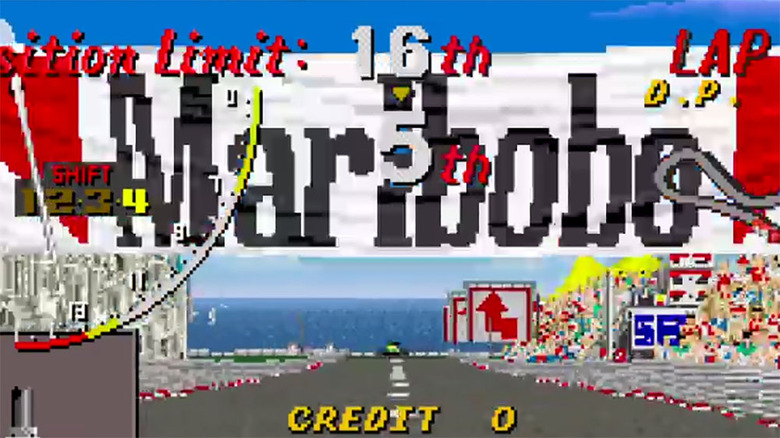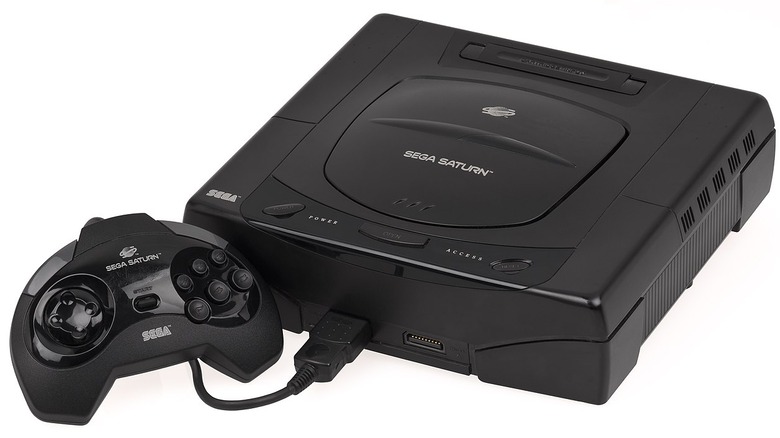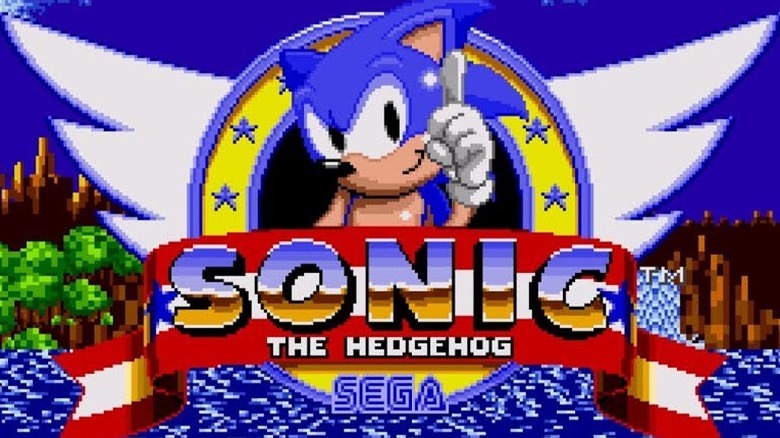The Shady Side Of Sega
As any long-suffering Nintendo fan will tell you, Sega's never been any good. Back in the '90s, when the console wars were still raging, Nintendo was the nice guy. Sega was irreverent, rude, and full of 'tude — and the company wouldn't have had it any other way.
Back then, however, nobody knew exactly how low Sega would sink. Stealing other people's ideas? Oh, Sega will do it. Lie to customers? Be careful. It's happened before. In its efforts to peddle video games to the masses, it turns out that there are very few lines that Sega won't cross.
Don't assume that Sega's shady side faded away alongside POGs and Beanie Babies, either. The company's shady behavior continues to this day. Go ahead and take a look at some of the most egregious acts in Sega's history, but be warned: some things you can't unsee. You'll never look at Sonic the same way ever again.
The cancer stick controversy
Peddling cigarettes to children is a problem, but you know what's even worse? Peddling cigarettes to children even when the company that makes the cigarettes doesn't want you to. And yet, neither trademark concerns nor common decency stopped Sega from cramming the arcade game Grand Monaco GP full of ads for Marlboro-brand smokes without permission from Marlboro's parent company, Philip Morris.
Okay, sure, technically Grand Monaco GP's in-game signs read "Marlbobo" and not "Marlboro," but the font, color, and general layout of the ads are basically the same as Philip Morris' cigarette logo. When you're busy racing around the track, you're not going to notice a simple spelling mistake. Dr. John W. Richards, who filed the complaint about Grand Monaco GP's in-game ads with the FTC, estimated that a decent player will run across hundreds of bootleg Marlboro ads during a single Grand Monaco GP session.
Naturally, Philip Morris washed its hands of the in-game ads — back in the late '80s, cigarette companies were already facing intense criticism for advertising to kids — and sued Sega for copyright infringement. They won. But if Philip Morris and Sega didn't have a publishing deal, how did the Marlboro ads end up in Grand Monaco GP in the first place? Sega's David Rosen chalked it up to an "innocent attempt to mimic real-life" F1 races, which are full of ads for booze and cigarettes — and yet, somehow, are still considered child-friendly.
The athletic wear ad rip-off
If you can't come up with a good idea of your own, just steal someone else's. That's more or less what Sega did back in 2002, when it ripped off Nike's iconic "Frozen Moment" ad in order to promote the Dreamcast title NBA 2K2.
It's not like Sega took the same general concept (time slows down both on and off the court during a particularly spectacular basketball play) and made Frozen Moment its own, either. As Nike's lawyers pointed out, Sega's commercial was practically a shot-for-shot remake of Frozen Moment. Where the original ad has a jogger, NBA 2K uses a hamster running in a wheel. An overflowing sink becomes a spilled energy drink. Those aren't exactly the same, but c'mon. They're awfully close.
Nike sued, and without a strong legal argument to rely on, Sega decided to settle instead of engaging in a lengthy court battle. As part of the agreement, Sega forked over $100,000 to the Boys & Girls Club, shelved the ad, and apologized. That's not an outright admission of guilt, but given the situation, it's pretty easy to see who's in the wrong here — and it's not the people who make shoes.
The misleading menu mix-up
Sega doesn't just develop video games. It runs restaurants, too, and wouldn't you know it, they're just as sketchy as some of the company's more high-tech products. In 2013, 19 Japanese eateries managed and run by Sega Entertainment came under scrutiny for misleading customers, specifically by listing ingredients on the menu that weren't used in the final product.
For example, menus Sega's dart-themed Bee restaurants promised diners organic vegetables, premium diced steak, and meals prepared with locally-grown food from Japan's Hokkaido prefecture. However, many of the ingredients were grown overseas, meat options were beefed up with tallow (a.k.a. fat gathered from animal byproducts), and the tomatoes were just regular old tomatoes, with nothing special about 'em. On its own, that's not too bad, but the cheaper ingredients weren't reflected on the check. Affected dishes still carried premium price tags, and many ripped-off customers ended up paying for higher-quality food than they received, going home none the wiser.
Sega attributed the mix-up to an outdated menu and offered disenfranchised customers coupons for free meals — because after a restaurant rips you off and serves you low-quality food in order to make a quick buck, the first thing you want to do is go eat there again. Thanks, Sega, but no thanks. We'll take our business elsewhere.
The crane game con
You know that you're probably not going to win that large stuffed animal or pricey piece of electronics from vending machine games like the claw crane, but you might, and that small chance makes it worth it to pump the device full of money.
Don't bother with Sega's Key Master, though. If the owner at your local arcade read the manual correctly, then earning prizes like iPads and digital cameras has nothing to with skill. In 2013, Manhattan's C. Stewart Brown sued Sega after allegedly winning Key Master twice and getting nothing. In the suit, Brown claims that Key Master only doles out goodies after a certain amount of money has been put into the machine. The "game" part of the game is all for show.
As it turns out, Brown isn't just a sore loser. Online, Sega fans went through Key Master's user manual and found a couple of pretty shady settings. One fudges things so that the controls are inaccurate, making it harder to win. Another specifies a "payout rate" that limits how often Key Master hands out prizes (the default setting is once out of every 700 attempts). That makes Key Master a game of chance like a slot machine, not a game of skill. In other words, don't spend too much time trying to conquer the local Key Master machine. Unless you fill it with cash, you're walking away with bupkis.
The outer space bait and switch
Savvy video game fans know that most trade show demos are fake, but few are as egregiously misleading as the ones promoting Aliens: Colonial Marines. In a series of hands-off demonstrations of "actual gameplay," Sega and Gearbox showed press and consumers a gorgeous game that accurately captured the look and feel of James Cameron's sci-fi action flick.
Then, the game arrived. Instead of a slick shooter, Aliens: Colonial Marines was ugly and unsophisticated. The demo had a number impressive graphical flourishes, like detailed textures and dynamic lighting. In the final game, they weren't there. Whole levels were missing, and the highly-touted artificial intelligence was as dumb as rocks. Bugs — as in glitches, not aliens — ended up being Colonial Marines' biggest obstacles. Basically, for years Sega promoted one game, and then delivered something wildly different.
In the aftermath, stories about friction between Gearbox and Sega and outsourcing scandals helped explain where things went wrong, but by then it was too little, too late. Critics panned Colonial Marines, while customers retaliated with a lawsuit that accused Sega and Gearbox of false advertising — one that Sega found compelling enough that the company tentatively agreed to pay $1.25 million to pissed off fans.
The Sega Saturn launch snafu
It's hard to sell video games if nobody can find 'em, and most publishers go out of their way to keep retailers happy. Not Sega. At E3 1995, Sega made a surprise announcement: its latest console, the Sega Saturn, wouldn't release that September as planned. Instead, it was coming out that very day, four months before its planned release date. As Sega made the announcement, the consoles were already sitting in stores, just waiting for the Sega faithful to stop by and pick one up.
Some stores, anyway. While outlets like Toys R Us received shipments of Saturn consoles, Sega didn't bother letting other retailers in on the Saturn's surprise release. That didn't just leave eager customers empty-handed: some chains, including KB Toys, were so upset that they refused to carry the Saturn at all, giving all of Sega's precious shelf space to its competitors, the Sony PlayStation and the Nintendo 64.
It wasn't just retailers who were caught off guard. Sega didn't bother to let a number of its third-party partners know about the Saturn's new release date, either, and many resented the decision. As a result, a flurry of high-profile games moved from the Saturn to the PlayStation, leaving the Saturn's library bare. All that, and Sony held a press conference right after Sega's where the company announced that the PlayStation would cost $100 less than the Saturn, stealing any momentum that Sega gained from the Saturn's surprise launch. Ouch.
The spying Sonic scandal
Shady developers have released all kinds of bootleg Sonic the Hedgehog games on the Android app store, but at the very least, you'd expect Sega's official Sonic apps to respect its customers' privacy. You'd be wrong. According to Pradeo, a mobile security company, three of Sega's Sonic the Hedgehog apps are gathering user information and sharing it on the 'net — and it's not clear who, exactly, is benefitting from the exchange.
Specifically, Pradeo claims that Sonic Dash, Sonic Dash 2: Sonic Boom, and Sonic the Hedgehog Classic are collecting location and device data from users' mobile devices and sending the information to various servers, including at least three that Pradeo calls "uncertified." Even worse, Pradeo has identified two issues that could lead to "man-in-the-middle" attacks, as well as a handful of other security holes. All in all, the affected Sonic apps have about 15 vulnerabilities each.
This isn't a small problem, either. Sonic the Hedgehog is very, very popular, and up to 600 million users might be affected. In response to Pradeo's report, Sega told ZDNet that it's looking into the problems and will fix any issues that it runs across. Still, given that Sega had no idea that this information was exposed before Pradeo's article came out, it's not a great look for Sonic's home company, especially in light of all of the other sketchy things that Sega has done.
The abused emulation enthusiasts
If you're a fan of old games, you probably know RetroArch, the all-in-one emulator package that makes it easy to revisit some of your favorite titles from the past. Sega is familiar with the software, too. When Sega started working on Sega Forever, its line of free mobile ports of classic Genesis games, the company reached out to RetroArch developer Libretto for help.
On the surface, that sounds like a great opportunity, but Libretto confirmed that Sega wanted to do more than just partner up. As Libretto tells it, Sega wanted to relicense RetroArch with an agreement "that would strip us of all our rights." They didn't want to give Libretto or RetroArch any credit. Further, while developing a demo, developers asked Libretto to do complex work on nearly impossible deadlines. Libretto wisely told Sega to stuff it and moved on to other projects.
Sega Networks' chief marketing officer Mike Evans tells Eurogamer that the negotiations with Libretto went through a third party, not Sega itself, and that Sega has a perfectly fine set of emulators of its own, anyway. You wouldn't know it from playing the Sega Forever games. The titles that Sega eventually released run poorly, especially on newer hardware, and many fans are warning others to stay far, far away. Maybe if Sega had been less controlling, they'd have released a better final product. As it is, we'll never know.
The pilfered fan art
There's a lot of Sonic the Hedgehog fan art out there. Some of it's decent. A lot of it isn't. Occasionally, however, it's great — like, for example, DeviantArt user Lightning-Duchess' portrait of Sonia, which was so good that Sega decided to put it in an official Sonic video game. There's just one problem: they didn't get Lighting-Duchess' permission first.
Lightning-Duchess' drawing of Sonia, which is based on her look in the Sonic Underground episode "The Price of Freedom," appears in the Wii version of Sonic & Sega All-Stars Racing (and pops up as a low-resolution texture on the PC port, too). You can see it on the floor in the Roulette Road course, specifically on the queen of diamonds playing card. Naturally, Lightning-Duchess wasn't credited for her work, her name was cropped out of the image, and, given that it's fanart, she doesn't have any legal way of fighting against Sega's art theft.
At least she got an apology. As Duchess (real name Riana Dorsey) explained on DeviantArt, Sumo Digital's Steve Lycett reached out to the artist and explained that a level designer mistook Dorsey's picture for an official drawing and put it in the game, and when Sega told Sumo to remove the art, the studio forgot to do so on the Wii and PC versions of the game. Lycett apologized on behalf of the level designer, Dorsey accepted, and both went their separate ways.
The great Sony golf gag
Sega's never been shy about poking fun at its competitors (remember the whole "Nintendon't" campaign?), but good natured trash-talk is one thing. Crashing another company's party is another. That's what Sega of America president Bernie Stolar did in 1997, however, when the folks over at Sony decided to throw a company golf tournament in Napa Valley, California.
As Stolar tells Bitmob, the Sega executive went all out to an attempt to ruin the Sony top brass' good time. He paid the pro who ran the course to swap out all of the Sony-branded golf balls for ones with the Sega logo. He hired someone to cruise around the course in a golf cart while wearing a Sonic the Hedgehog costume, and he commission a skywriter to write "Dreamcast is coming" in the air above the green.
Of course, before Stolar worked at Sega, he was the executive vice president at Sony Computer Entertainment America, where he helped launch the PlayStation, so his act of sabotage was less vandalism and more like a prank between friends. According to Stolar, Sony's Kaz Hirai and Andrew House both thought that the joke was pretty funny. Still, it's Sony, not Sega, that ended up getting the last laugh: Stolar lost his job just before the Dreamcast launched, the console was discontinued after two measly years and tanked so hard that Sega left the hardware business entirely, and Sony's PlayStation 2 went on to become the best-selling video game console of all time.
The copyrighted character kerfuffle
Look, Batman, Spider-Man, Rambo, Godzilla, and the Terminator are all awesome characters, and seeing them all in a single-game would be great. Thanks to rights issues, however, it'll never happen — at least, not officially. Unofficially, though, Sega's already gone ahead and tossed them all (and a few others) into a single title. After all, as we've seen, if Sega wants to do something they're not going to let pesky things like "laws" get in the way.
Back in the day, the side-scrolling Genesis title Revenge of Shinobi was famous for its demanding platforming and unforgiving difficulty, but it's probably best known these days as an example of blatant and unapologetic copyright infringement. As director Noriyoshi Ohba explains, the team wanted to make an action game that felt "like a Hollywood action film," and Ohba based some quick enemy designs on popular characters. Unfortunately, Shinobi's main artist didn't realize that Ohba's sketches were supposed to be guidelines, not rules. The end result was a game filled with other people's characters, one that Sega decided to go ahead and release anyway. "Back then, copyright wasn't as strictly enforced," Ohba admits.
Except that it was enforced, and over time, Sega was forced to put out five different versions of Revenge of Shinobi to keep the lawyers at bay. Godzilla became a skeleton. Batman became a demon. Spider-Man stayed intact for a while (Sega actually had the rights to put that character in a game), but Sega had to add Marvel's copyright information to the game's credits, and he was eventually replaced by a pink doppelganger anyway.
Look, watching a ninja fight all of those guys is pretty cool, but copyrights exist for a reason. You can't just ignore them, even if — especially if — you're Sega.




